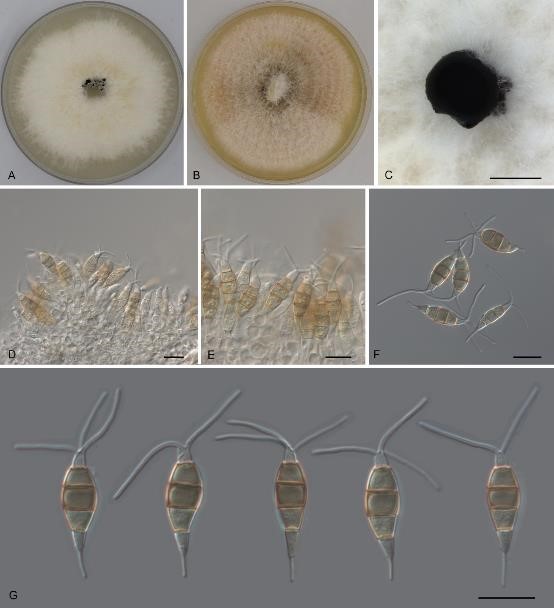Pestalotiopsis lithocarpi N. Jiang, in Jiang, Voglmayr, Xue, Piao & Li, Microbiology Spectrum: 10.1128/spectrum.03272-22, 17 (2022)
Index Fungorum number: IF 841312; MycoBank number: MB 841312; Facesoffungi number: FoF 11697;
Pathogenic to host leaves. Asexual state: Conidiomata in culture sporodochial, solitary, erumpent, pulvinate, black, 450–1100 μm diam., exuding black conidial masses. Conidiophores indistinct, usually reduced to conidiogenous cells. Conidiogenous cells hyaline, smooth, cylindrical to subcylindrical, annelidic, 4 to 10 by 3 to 5.5 μm, mean ± SD = 5.9 ± 2.8 by 4.2 ± 0.8 μm. Conidia fusoid, straight or slightly curved, 4-septate, smooth, slightly constricted at the septa, (17)18.5 to 21.5(23) by (5.5)6 to 7(8) μm, mean ± SD = 20.2 ± 1.4 by 6.6 ± 0.6 μm, L/W = 2.5 to 3.7; basal cell obconic with a truncate base, thin-walled, hyaline or pale brown, (3.5)4 to 5 μm; median cells 3, trapezoid or subcylindrical, concolorous, brown, thick-walled, the first median cell from base (3.5)4 to 5 μm long, the second cell 4 to 4.5(5) μm long, the third cell 4 to 5 μm long, together 12.5 to 14(14.5) μm long; apical cell conic with an acute apex, thin-walled, hyaline, (2.5)3 to 3.5 μm long; basal appendage unbranched, tubular, centric, straight or slightly bent, 2.5 to 4.5(5) μm long, mean ± SD = 3.6 ± 0.8 μm; apical appendages, 2 to 4 (mostly 3), unbranched, tubular, centric, straight or slightly bent, (9)12.5 to 21(24) μm long, mean ± SD = 16.7 ± 4.1 μm. Sexual morph unknown.
Culture Characters – Colonies on MEA flat, spreading, with flocculent aerial mycelium forming concentric rings and entire edge, umber, reaching a 70-mm diameter after 10 days at 25°C, forming black conidiomata with black conidial masses; on PDA, flat, spreading, with flocculent aerial mycelium and feathery edge, white to pale luteous, reaching a 65-mm diameter after 10 days at 25°C, forming black conidiomata with black conidial masses.
Material examined – China, Hainan Province, Changjiang Li Autonomous County, Bawangling National Forest Park, on diseased leaves of Lithocarpus chiungchungensis, 30 March 2019, Yong Li (holotype CAF 800025; ex-holotype culture CFCC 55100); ibid., CFCC 55893.
Distribution – China
Sequence data – ITS: OK339742 (ITS1/ITS4); tef1: OK358503 (EF1-728F/EF2); tub2: OK358518 (Bt2a/Bt2b)
Notes – Two isolates from leaf spots of Lithocarpus chiungchungensis clustered into a well-supported clade newly described here as Pestalotiopsis lithocarpi (Fig. 1). Phylogenetically, P. lithocarpi is close to P. dracontomelonis from diseased leaves of Dracontomelon dao (Anacardiaceae) collected in Thailand. Pestalotiopsis lithocarpi is similar to P. dracontomelonis in conidial size (17 to 23 by 5.5 to 8 μm in Pestalotiopsis lithocarpi versus 18 to 23 by 5.5 to 7.5 μm in P. dracontomelonis) (27). However, they can be distinguished by the length of the three median cells (12.5 to 14.5 μm in P. lithocarpi versus 13 to 17 μm in P. dracontomelonis) (27). In addition, P. lithocarpi can be distinguished from P. dracontomelonis by sequence data (nucleotide differences: in the ITS, 2/505 [0.4%], 1 insertion; in tef1, 5/457 [1.2%], 7 insertions).

Fig. 15. Morphology of Pestalotiopsis lithocarpi (CFCC 55100). A. Colony on PDA after 10 d at 25 °C; B. Colony on MEA after 10 d at 25 °C; C. Conidioma formed on PDA; D, E. conidiogenous cells giving rise to conidia; F, G. conidia. — Scale bars: C = 500 μm; D–G = 10 μm.
